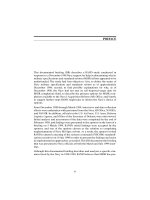VIRTUE ETHICS AND PROFESSIONAL ROLES docx
Bạn đang xem bản rút gọn của tài liệu. Xem và tải ngay bản đầy đủ của tài liệu tại đây (666.47 KB, 201 trang )
VIRTUE ETHICS AND
PROFESSIONAL ROLES
Professionals, it is said, have no use for simple lists of virtues and
vices. The complexities and constraints of professional roles create
peculiar moral demands on the people who occupy them, and traits
that are vices in ordinary life are praised as virtues in the context of
professional roles. Should this disturb us, or is it naive to presume
that things should be otherwise? Taking medical and legal practice
as key examples, Justin Oakley and Dean Cocking develop a rigor-
ous articulation and defence of virtue ethics, contrasting it with
other types of character-based ethical theories and showing that it
offers a promising new approach to the ethics of professional roles.
They provide insights into the central notions of professional
detachment, professional integrity, and moral character in profes-
sional life, and demonstrate how a virtue-based approach can help
us better understand what ethical professional–client relationships
would be like.
is Director of the Monash University Centre for
Human Bioethics. His publications include Morality and Emotions
() and a number of journal articles.
is Senior Research Fellow at the Centre for
Applied Philosophy and Public Ethics, Charles Sturt University. He
has published articles in journals including Ethics and the Journal of
Philosophy.
This page intentionally left blank
VIRTUE ETHICS AND
PROFESSIONAL ROLES
JUSTIN OAKLEY
Monash University
DEAN COCKING
Charles Sturt University
PUBLISHED BY CAMBRIDGE UNIVERSITY PRESS (VIRTUAL PUBLISHING)
FOR AND ON BEHALF OF THE PRESS SYNDICATE OF THE UNIVERSITY OF
CAMBRIDGE
The Pitt Building, Trumpington Street, Cambridge CB2 IRP
40 West 20th Street, New York, NY 10011-4211, USA
477 Williamstown Road, Port Melbourne, VIC 3207, Australia
© Justin Oakley and Dean Cocking 2001
This edition © Justin Oakley and Dean Cocking 2003
First published in printed format 2001
A catalogue record for the original printed book is available
from the British Library and from the Library of Congress
Original ISBN 0 521 79305 X hardback
ISBN 0 511 01597 6 virtual (netLibrary Edition)
To my partner, Kathryn Bailey, for her patience, support, and understand-
ing, and our loving son, Jordan Bailey Oakley, for the life that awaits him.
Justin Oakley
To my father, Gordon, whose love, humour, sensitivity, and insight I
adored and continue to miss greatly. To my beautiful mother, Yvonne, loving
brother, Peter, and wonderful son, Harry.
Dean Cocking
This page intentionally left blank
Contents
Preface page ix
Acknowledgements xii
Introduction
The nature of virtue ethics
The regulative ideals of morality and the problem of
friendship
A virtue ethics approach to professional roles
Ethical models of the good general practitioner
Professional virtues, ordinary vices
Professional detachment in health care and legal practice
Bibliography
Index
vii
This page intentionally left blank
Preface
There are many people we wish to thank for their support in the course
of writing this book. Work on the book began during –, with the
help of a Large Research Grant from the Australian Research Council.
We are grateful to the ARC for supporting this project from the outset.
For his encouragement and enthusiasm about the project from the
beginning, and for his helpful comments on the work in progress (espe-
cially in the early stages) we would like to thank Michael Smith.
Michael’s interest in the project helped to get it off the ground, and he
has been an inspiration to us both, as he has been to many of his col-
leagues and students. For his detailed and incisive comments on every
chapter, several times over, we are deeply indebted to John Campbell.
John read our drafts very carefully, and his feedback was extremely valu-
able. He helped us refine our arguments at many points, and raised
many useful questions about virtue ethics that would not otherwise have
occurred to us. Warm thanks are also owed to Jennifer Radden for her
valuable and stimulating comments on the entire typescript. Two anony-
mous readers for Cambridge University Press also provided very exten-
sive comments on the penultimate draft, and their detailed suggestions
resulted in many improvements to the typescript. We are also grateful to
Jeanette Kennett, for discussing many of the issues in this book with us,
and to Tim Dare, for his spirited rejoinder to a paper which was an
earlier version of chapter .
Extensive comments on various chapters were provided by John
Cottingham, Owen Flanagan, Lynn Gillam, Brad Hooker, Tom Hurka,
David Sosa, Christine Swanton, and the editors of Ethics, and we are
indebted to all of them for their help. We are also grateful for the feed-
back we received from Lori Gruen, R. M. Hare, Elinor Mason, Steve
Matthews, Bernadette McSherry, Jeannie Paterson, Philip Pettit,
Gerald Postema, Per Sandberg, Peter Saul, Julian Savulescu, Peter
Singer, Michael Stocker, and Bernadette Tobin. Valuable references
ix
were suggested to us by Minou Friele, David Macintosh, Ani Satz,
Merle Spriggs, and Alison Stubbs. Dean would also like to thank the
Department of Philosophy at the University of Auckland, for their
support in the form of a Post-Doctoral Fellowship, and in particular
team captain Tim Dare. For his enthusiasm about the project and his
general encouragement, we also thank Robert Young.
Earlier versions of the chapters in this book have been read to various
audiences over the years, as indicated in the notes to each chapter. Along
with those audiences, we would also like to thank Rae Langton and
Michael Smith for organising the ‘Consequentialism, Kantianism, and
Virtue Ethics’ conference at Monash University in June , which was
an excellent international forum at which to read an earlier version of
chapter . We are also grateful to Tony Coady and Megan Laverty, for
helping organise the symposium on ‘Virtue Ethics and Professional
Roles’, at the Australian Association for Professional and Applied Ethics
Fourth Annual Conference held at the University of Melbourne in
September , where we read an earlier version of Chapter . Justin
would also like to thank Daisuke Arie of Yokohama City University,
Yasunori Fukagai of Tokyo Metropolitan University, and Satoshi
Kodama of Kyoto University for organising ethics symposia in Tokyo
and Kyoto, where a version of Chapter was read in January .
On a more practical level, we wish to express our appreciation to
Hilary Gaskin, Philosophy Editor at Cambridge University Press, for her
patience, professionalism, and promptness. We also thank copy-editor
Pauline Marsh for her meticulousness and her suggestions for stylistic
improvements. Monash University generously provided Justin with two
periods of study leave, which enabled significant progress to be made on
this project. Justin also wishes to thank David and Beverley Macintosh,
for their kindness in making available the library of their wonderful
house as a peaceful area in which to write, and the Faculty of Arts staff
at Monash Caulfield Campus, who provided a quiet temporary office
away from the distractions of the Clayton campus. Dean is especially
grateful to Seumas Miller for providing him with the research time to
finish work on this book and for his tremendous support and encour-
agement more generally. For general administrative assistance, Justin
would like to thank Heather Mahamooth, from the Monash University
Centre for Human Bioethics.
We are personally indebted to a number of people for their support
over the years this book was written. Justin wishes to express his heart-
felt appreciation to his partner, Kathryn Bailey, for her unfailing loyalty
x Preface
and support, and to his son Jordan, for the lightness and joy he has
brought during these years. Most of all Dean would like to thank his
mother, Yvonne, whose continuing devotion and support have been
enormous and contributed so much to his life.
Preface xi
Acknowledgements
Sections of the following chapters draw on our previously published
material, as indicated. Permission to adapt and use parts of that mater-
ial has been kindly granted by the publishers, as noted.
Chapter : ‘Varieties of Virtue Ethics’, Ratio ,no., September ,
pp. –. Copyright (c) by Blackwell Publishers Ltd. ‘A Virtue
Ethics Approach’, in Helga Kuhse and Peter Singer (eds.), A Companion
to Bioethics, Oxford, Blackwell, ,pp.–. Copyright (c) by
Blackwell Publishers Ltd.
Chapter : ‘Indirect Consequentialism, Friendship, and the Problem
of Alienation’, Ethics ,no., October ,pp.–. Published by
The University of Chicago Press. Copyright (c) by The University
of Chicago. All rights reserved.
Chapter : ‘Doing Justice to the Lawyer’s Role’, in Andrew Alexandra,
Tony Coady, and Bruce Langtry (eds.), Proceedings of the Fourth Annual
Conference of the Australian Association for Professional and Applied Ethics,
Melbourne, University of Melbourne Centre for Philosophy and Public
Issues, ,pp.–. Copyright (c) by A. Alexandra, T. Coady,
and B. Langtry.
Chapter : ‘The Ethics of Professional Detachment’, Journal of Law
and Medicine ,no., November ,pp.–. This article has been
incorporated into chapter with the express permission of (c) LBC
Information Services, a part of Thomson Legal and Regulatory Group
Asia Pacific Limited.
xii
Introduction
Professionals, it is said, have no use for simple lists of virtues and vices.
The complexities and constraints of professional roles create peculiar
moral demands on the individuals who occupy them. Traits that are
vices in ordinary life are praised as virtues in the context of professional
roles. Should this disturb us, or is it naive to presume that things should
be otherwise?
It is natural to turn for guidance on such matters to recent work in
virtue ethics. Unfortunately, however, much of this writing suffers from
a lack of detail about how the approach is to be applied to practical
issues. This book is an attempt to address that problem. In what follows
we develop a clear and rigorous account of virtue ethics, which explains
how it differs from contemporary versions of rival ethical theories. We
show why virtue ethics is to be preferred to those views, and explain how
it offers a natural and promising approach to the ethics of professional
roles. In doing so, we bring out how a properly developed virtue ethics
can offer a promising way to resolve a central issue in professional ethics,
in its ability to account for how professional roles can legitimately have
their own action-guiding force, without compromising the broader
values to which those roles are answerable.
Our general aim is to show how a theoretically advanced virtue
ethics offers a plausible and distinctive alternative to utilitarian and
Kantian approaches to understanding and evaluating professional roles
– in particular, the role morality of medical and legal practice. We
argue for the merits of virtue ethics over these other approaches on
both theoretical and practical grounds. In the theoretical chapters of
the book, we develop the notion of a ‘regulative ideal’ as a way of expli-
cating the relation between an ethical theory’s criterion of rightness
and its account of how agents are to be guided by this criterion. We
draw on this notion in outlining a rigorous virtue-based account of
moral justification, and in comparing and defending this account
against its Kantian and consequentialist rivals. Following this, we go on
to provide an outline of a virtue-based approach to professional roles,
which we then apply to medical and legal practice.
The rise of systematic approaches to professional ethics in the s
saw traditional practices in various professions subjected to critical scru-
tiny by broad-based ethical theories, such as utilitarianism and
Kantianism. For instance, doctors were told that it is unethical to with-
hold a diagnosis from a patient out of concern for the patient’s welfare,
for telling patients the truth here respects their rights or maximises utility
overall. Similarly, lawyers acting for the defendant in a rape trial have
been advised to avoid making gratuitous courtroom references to the
plaintiff’s sexual history in order to impugn her character, as such
conduct violates her rights and is in any case counterproductive to the
administration of justice overall, because it deters many rape victims
from reporting the assault in the first place. Many have welcomed this
sort of external critical evaluation of previously accepted professional
norms, which they rightly feel was well overdue. Indeed, some have gone
on to suggest that professional norms are themselves redundant and that
reliance upon them is pernicious. Robert Veatch, for instance, argues
that ‘the use of a professionally generated ethic makes no sense in theory
or in practice’, and he suggests that we instead appeal directly to more
general moral standards.
1
However, other writers have recently criticised the suggestion that
professional ethical norms should be abandoned in favour of an
approach which judges professional behaviour directly in terms of
broad-based moral standards. They feel that something important is lost
in the move to the general here. For example, Larry Churchill and
Charles Fried have argued that utilitarianism and Kantianism fail to reg-
ister certain role-generated commitments and characteristic sensitivities
of good doctors, and Fried has put forward a similar argument about the
distinctive requirements of the lawyer’s role. Lawrence Blum has like-
wise made claims about the inadequacies of universalist ethical theories
in capturing what it is to be a good teacher.
These critics seem to us correct in saying that an approach which
judges the legitimacy of all professional behaviour directly in terms of
broad-based moral standards will not do justice to the responsibilities
and sensitivities proper to various professional roles, and that a satisfac-
tory ethic for a given profession must be able to recognise the particular
Virtue ethics and professional roles
1
Robert M. Veatch, A Theory of Medical Ethics, New York, Basic Books, ,p..
roles, responsibilities, and sensitivities appropriate to that profession. In
the later chapters of the book, we discuss a range of problems that con-
sequentialist and Kantian ethical theories might have in accommodat-
ing the distinctive requirements and sensitivities appropriate to various
professional roles. But whatever implications such difficulties have for
Kantian and utilitarian approaches to professional roles, we argue that
virtue ethics has the resources to deal with the various problems we raise
here.
Indeed, the topic of professional roles presents a particularly good
example of how virtue ethics may be applied in practice, as the focus of
virtue ethics on functions and ends fits well with professional practice,
which can be readily regarded as having a teleological structure. The
proper goals of a particular profession also tend to be clearer, more spe-
cific, and more widely recognised than do the characteristic functions
and ends of human beings generally.
Chapter provides a systematic account of the essential and distinc-
tive positive features of a virtue-based approach to normative ethics. We
explain how a virtue ethics form of character-based ethics differs from
recent character-based forms of Kantian and consequentialist theories,
and we defend virtue ethics against several important criticisms which
are commonly made in philosophical discussions of the approach.
In chapter we argue for the superiority of a virtue ethics approach
to contemporary consequentialist and Kantian theories, on the grounds
that virtue ethics can appropriately recognise the nature and value of
friendship, whereas consequentialism and Kantianism are unable to do
so. The inadequacies we identify in consequentialist and Kantian treat-
ments of friendship are instructive for our purposes in this book. For, as
many recognise, the plausibility of any ethical theory rests importantly
on its capacity to recognise great human goods, of which friendship is
clearly one, and consequentialists and Kantians have done much work
recently in attempting to accommodate the value of friendship. But
further, the problems which impartialist ethical theories like consequen-
tialism and Kantianism have in accommodating friendship will be
helpful, by way of contrast and similarity, in understanding the problems
these theories have in giving due acknowledgement to the value and nor-
mative force of various professional roles. Both friendship and profes-
sional roles may license departures from what universalist or impartialist
ethical theory would ordinarily require of us, and the values inherent in
both friendship and various professional roles seem significantly inde-
pendent of the values contained in universalist and impartialist ethical
Introduction
theories. However, as we show in chapter , section , the nature of and
justifications for this independence and these departures from broad-
based ethical theory that might be claimed for friendship and profes-
sional roles are importantly different.
Chapter outlines how virtue ethics can provide a plausible frame-
work for evaluating professional roles. We argue that good professional
roles must be part of a good profession, and that a good profession is one
which involves a commitment to a key human good, a good which
humans need to live flourishing lives. Several virtues specific to medical
practice are then outlined and defended at the end of this chapter.
Our arguments against consequentialism in chapters and comple-
ment each other. Two distinct sorts of critique can be made of conse-
quentialist justifications of friendship. One might attack the empirical
claim made by many consequentialists that engaging in relationships
such as friendship is by and large the way in which individuals can
produce the most agent-neutral good. Alternatively, one might question
whether the sorts of relationship a consequentialist agent is permitted to
have with others would really qualify as friendships, quite apart from
whether the agent’s engaging in those relationships does produce the
most agent-neutral good. For example, one might examine whether the
governing conditions that consequentialist agents must impose on their
relationships preclude any such relationship from being a friendship. In
chapter , we offer an argument against consequentialism along the lines
of this second critique, and we leave aside consequentialists’ empirical
claim about friendships maximising the good. Some consequentialists
have justified certain professional roles by making the empirical claim
that those professionals produce the most agent-neutral good by engag-
ing in such roles. When we go on to discuss professional roles, we attack
this empirical claim made by certain consequentialists in relation to a
general practitioner’s commonly accepted partiality towards their own
patients. Thus, in chapter we argue that there are good reasons for
thinking that such devotion to one’s own patients will not in fact maxi-
mise the good, and we bring out the complacency on the part of conse-
quentialists who provide little evidence for the plausibility of such a
claim. We also demonstrate some limitations of influential personal rela-
tionship models of the partiality which might be thought appropriate to
various professional–client relationships.
Chapter addresses the limits which the general conception of the
virtuous agent might be justifiably thought to impose on the exercise of
role-based virtues in professional life. Here we focus on lawyers’ roles,
Virtue ethics and professional roles
and we argue that virtue ethics can consistently recognise the distinctive
value of a lawyer’s role and its associated virtues, while also holding that
a lawyer ought not to fulfil those role requirements where doing so would
involve a gross violation of justice.
In chapter we examine what sorts of psychological integration
between their personal and professional life would characterise a virtu-
ous person, and we discuss what virtue ethics might say about various
sorts of psychological distancing from one’s professional role and its
apparent requirements. Here, by drawing attention to the Kantian con-
ception of the limits of the moral self, we also provide a critique of how
Kantian ethics might understand the morality of professional roles.
There has been much writing in virtue ethics, and a good deal said
about its promise, yet comparatively few works have really delivered on
that promise. Much work in virtue ethics, for all its value, often lacks
crucial details about the nature of the approach and about how it differs
from the more sophisticated forms of rival theories which have been
developed recently. As a result, there has been a certain lack of engage-
ment, both in ethical theory and applied ethics, between the advocates
of virtue ethics and those who take more traditional views. Our hope in
writing this book is that it initiates greater dialogue between the advo-
cates of virtue ethics and utilitarian and Kantian approaches, and that
it reveals the richness and strength of a more developed and rigorous
account of virtue ethics.
Introduction
This page intentionally left blank
The nature of virtue ethics
1
The current renewal of philosophical interest in the virtues is one of the
most noteworthy developments in contemporary ethical theory. The
first signs of this revival appeared in , when Elizabeth Anscombe
called for the restoration of Aristotelian notions of goodness, character,
and virtue as central concerns of moral philosophy.
2
While initial reac-
tions to Anscombe’s call were modest, interest in the virtues gathered
momentum during the s, largely because of the work of philoso-
phers such as Philippa Foot, Bernard Williams, and Alasdair MacIntyre.
The philosophical literature on the virtues is now vast, and there is a
great variety of different views which advertise themselves as forms of
virtue ethics.
3
Many of those who hold such views argue that virtue
ethics can lay serious claim to rival Kantianism and utilitarianism as
comprehensive normative ethical theories. But what exactly is virtue
ethics? What are the central claims which the variants of virtue ethics
1
Earlier versions of this chapter were read at the ‘Consequentialism, Kantianism, and Virtue
Ethics’ conference at Monash University, at an Ethox seminar at Oxford University, at Kyoto
University, and at a seminar in Tokyo organised by the utilitarian studies research group in Japan.
We would like to thank those audiences for useful discussion on those occasions. We are especially
grateful to John Campbell, John Cottingham, Brad Hooker, Per Sandberg, and Christine
Swanton, for their very helpful comments on previous versions, and to Kazunobu Narita for his
detailed critique of a late draft of this chapter.
12
G. E. M. Anscombe, ‘Modern Moral Philosophy’, Philosophy , .
13
A comprehensive bibliography of material on virtue ethics can be found in Robert B. Kruschwitz
and Robert C. Roberts, The Virtues: Contemporary Essays on Moral Character, Belmont, Wadsworth,
. For good recent collections of papers on virtue ethics, see Roger Crisp (ed.), How Should One
Live? Essays on the Virtues, Oxford, Clarendon Press, ; Roger Crisp and Michael Slote (eds.),
Virtue Ethics, Oxford, Oxford University Press, ; Peter A. French, Theodore E. Uehling, and
Howard K. Wettstein (eds.), Midwest Studies in Philosophy, Volume : Ethical Theory: Character and
Virtue, Notre Dame, Notre Dame University Press, ; and Daniel Statman, Virtue Ethics: A
Critical Reader, Edinburgh, Edinburgh University Press, . See also the survey articles on virtue
ethics by Gregory E. Pence, ‘Recent Work on the Virtues’, American Philosophical Quarterly , ;
and Gregory Trianosky, ‘What is Virtue Ethics all About?’, American Philosophical Quarterly , .
Pence summarises and compares certain key texts in the recent history of virtue ethics, while
Trianosky offers a more systematic guide to the different forms of virtue ethics, in terms of a
range of common targets which unite various writers in the field.
share, and how is virtue theory distinct from other, more familiar ethical
theories?
There is a somewhat bewildering diversity of claims made by philos-
ophers in the name of virtue ethics. Many of those claims are put in neg-
ative form, and are expressed in terms of an opposition to an ‘ethics of
principles’, or to an ‘impartialist ethics’, or to ‘abstract ethical theory’,
or simply to an ‘ethics of action’. Unfortunately, this negative emphasis
has resulted in virtue ethics becoming better known to many by what it
is against, rather than by what it is for. Of course, given that the revival of
virtue ethics has been sparked by dissatisfaction with standard Kantian
and utilitarian ethical theories, it is not surprising that those negative
claims have gained prominence. However, to focus only on those claims
in an outline of virtue ethics and its variants would be inadequate, for
this would not sufficiently distinguish it from other approaches – such as
an ethics of care, and various forms of feminist ethics – which are also
often advanced in terms of a rejection of similar features of orthodox
ethical theories. While virtue ethics does share certain common targets
with these and other ethical theories, it can be more clearly distinguished
from them by its positive features.
When virtue ethicists do enunciate their positive claims, however, there
is often a lack of clarity and specificity which does not help in fixing the
theory’s distinctive content. Thus, when virtue ethicists suggest how the
theory can overcome many of the perceived vices of Kantianism and
utilitarianism, there is often a failure to articulate virtue theory in ways
which make clear how or why its features cannot simply be appropriated
by more sophisticated or ecumenical forms of these more familiar ethical
theories. For example, many regard virtue ethics’ emphasis on an agent’s
character in justifying right actions as a feature which distinguishes virtue
ethics from other ethical theories. However, while the virtue ethics move-
ment has helped bring considerations of character to the fore in contem-
porary ethics, it is not alone in emphasising the important connections
between right action and an agent’s character. For recent influential ver-
sions of Kantianism and consequentialism have also moved towards
endorsing the idea that the morally good person would have a certain
sort of character.
4
So, while many writers on virtue ethics assume that
arguments for the importance of character necessarily lend support to a
Virtue ethics and professional roles
4
See, for example, Barbara Herman, ‘The Practice of Moral Judgment’, and other essays in her
The Practice of Moral Judgment, Cambridge, , Harvard University Press, ; and Peter Railton,
‘Alienation, Consequentialism, and the Demands of Morality’, in Samuel Scheffler (ed.),
Consequentialism and its Critics, Oxford, Oxford University Press, .
virtues-based approach to ethics, the moves by contemporary Kantians
and consequentialists to recognise the importance of character in evalu-
ating actions indicate that this broad assumption is unjustified. What
virtue ethicists need to show, in addition to the importance of character,
is what makes a virtue ethics form of character-based ethics distinctive, and
why such an approach is to be preferred to character-based forms of
Kantianism and consequentialism. Thus, in order to show how virtue
ethics resists assimilation to a form of Kantianism or utilitarianism, one
needs to bring out which features of virtue ethics could not consistently
be endorsed by someone who holds one of those theories.
In this chapter we set out the basic features of virtue ethics, by pre-
senting a systematic account of its main positive claims, and by showing
how these claims help to distinguish it from other approaches. We also
develop certain aspects of this basic virtue ethics approach, introducing
the concept of a ‘regulative ideal’, and demonstrating how this concept
helps to clarify and strengthen virtue ethics. At the end of the chapter,
we consider several criticisms of virtue ethics which are commonly made
by philosophers, and we discuss how virtue ethics might be defended
against these criticisms.
There are at least six claims which seem to be essential features of any
virtue ethics view. The first and perhaps best-known claim, which is
central to any form of virtue ethics, is the following:
(a) An action is right if and only if it is what an agent with a virtu-
ous character would do in the circumstances.
This is a claim about the primacy of character in the justification of right
action. A right action is one that is in accordance with what a virtuous
person would do in the circumstances, and what makes the action right is
that it is what a person with a virtuous character would do here.
5
Thus,
as Philippa Foot argues, it is right to save another’s life, where life is still
a good to that person, because this is what someone with the virtue of
benevolence would do. A person with the virtue of benevolence would
act in this way because benevolence is a virtue which is directed at the
good of others, and to have the virtue of benevolence, according to Foot,
The nature of virtue ethics
5
For an explicit statement of this claim, see, e.g., Rosalind Hursthouse, ‘Virtue Theory and
Abortion’, Philosophy and Public Affairs , ,p.. See Aristotle, Nicomachean Ethics
..a–.
is to be disposed to help others in situations where we are likely to be
called upon to do so.
6
Similarly, as Rosalind Hursthouse argues, it is right
in certain circumstances to reveal an important truth to another, even
though this may be hurtful to them, because a person with the virtue of
honesty would tell the truth here. For example, if my brother asks me
whether his wife is being unfaithful, and I happen to know that she is, I
ought to answer him truthfully because this is what a person with the
virtue of honesty would do here.
7
Likewise, in regard to justice, Foot
argues that I ought to repay you the money I have borrowed, even if you
plan to waste it, because repaying the money is what a person with the
virtue of justice would do.
8
Now, as we noted above, the primacy given to character in (a) might
also seem to be endorsed by recent influential forms of Kantianism, con-
sequentialism, and utilitarianism, which invoke one of these theories to
give content to the notion of a ‘virtuous person’. For example, Barbara
Herman has argued that the Kantian Categorical Imperative, which
provides the standard of rightness for actions, is best understood as a
normative disposition in the character of a good agent to rule out certain
courses of conduct as impermissible.
9
Similarly, Peter Railton has
argued that the consequentialist requirement to maximise agent-neutral
value can be understood as a normative disposition in the character of
the good agent, and R. M. Hare suggests that the utilitarian requirement
to maximise utility can be thought of in the same way.
10
How can (a) help
distinguish virtue ethics from these other theories?
Virtue ethics gives primacy to character in the sense that it holds that
reference to character is essential in a correct account of right and wrong
action. However, the examples from Foot and Hursthouse do not bring
out fully how virtue ethics envisages (a) operating as a standard for deter-
mining the rightness of actions. For (a) might be proposed as providing
a purely ‘external’ criterion of right action, which a person may meet no
matter what kinds of motives, dispositions, or character they act from in
performing the action the criterion directs them to do. On this interpre-
tation, acting rightly would not require modelling oneself on a virtuous
Virtue ethics and professional roles
16
See Philippa Foot, ‘Euthanasia’, p. ; and ‘Virtues and Vices’, p. , both in her Virtues and Vices,
Berkeley, University of California Press, . Foot sometimes calls this virtue ‘benevolence’,
while at other time she refers to it as ‘charity’.
17
See Hursthouse, ‘Virtue Theory and Abortion’, pp. , .
18
See Foot, ‘Euthanasia’, pp. –, and ‘Virtues and Vices’. See also William Frankena, Ethics, nd
edn, Englewood Cliffs, Prentice-Hall, ,pp.–.
19
See Herman ‘The Practice of Moral Judgment’.
10
Railton, ‘Alienation’; and R. M. Hare, Moral Thinking, Oxford, Oxford University Press, .
person or a particular aspect of their character, but would involve just
having a good idea of what kinds of acts such a person would perform
in various circumstances. In that case, (a) would be analogous to the role
in certain ethical theories of an Ideal Observer, whose deliverances may
guide one even though one lacks the qualities of such an observer oneself
(and indeed, even if there were no ‘natural’ persons who embodied all
the characteristics of an Ideal Observer).
11
Alternatively, the criterion of
right action in (a) might be proposed as carrying certain ‘internal’
requirements, such that a person can act rightly only if they themselves
have and act out of the kinds of motives, dispositions, or character-traits
that a virtuous agent would have and act out of in the circumstances.
Now, it is clear from (a) that virtue ethics makes character essential to
right action at least in the sense that its criterion of rightness contains an
essential reference to the character of a hypothetical figure – namely, a
virtuous agent. And this feature is already enough to distinguish virtue
ethics from forms of act-utilitarianism and act-consequentialism which
evaluate an act according to the consequences that it actually results in,
as Railton’s act-consequentialism does. For unlike virtue ethics, these
actualist approaches allow us to say what acts are right, with no refer-
ence to the character of a hypothetical agent (or, for that matter, to the
character of the real agent whose action is being evaluated) at all. For
these actualist versions of act-utilitarianism and act-consequentialism
hold simply that an act is right if and only if it results in the best conse-
quences.
12
However, many contemporary utilitarians and consequentialists
repudiate actualism in favour of some form of expectabilist approach,
where actions are evaluated according to their likely consequences,
rather than their actual consequences. One widely held expectabilist
form of act-consequentialism evaluates an act according to the conse-
quences it is objectively likely to result in, and this approach can be inter-
preted as having a criterion of rightness containing an essential
reference to the character of a hypothetical figure.
13
For this form of
The nature of virtue ethics
11
See Roderick Firth, ‘Ethical Absolutism and the Ideal Observer’, Philosophy and Phenomenological
Research , . We thank John Campbell for pointing out this similarity between virtue ethics
and an Ideal Observer theory.
12
Railton uses the term ‘objective consequentialism’ to refer to what many call ‘actualism’.
13
For one account and defence of this approach, see Graham Oddie and Peter Menzies, ‘An
Objectivist’s Guide to Subjectivist Value’, Ethics ,no., April . This form of expectabil-
ism is to be distinguished from that form which evaluates an act according to the consequences
it is subjectively likely to result in. This subjectivist approach holds that the consequences relevant
to the act evaluation are those which the agent believes are probable consequences of the act
(rather than those which are objectively probable consequences of the act). For one account and
expectabilism can be presented as evaluating the rightness of an act by
looking at which of its possible consequences a reasonable person in the
agent’s position would judge to be likely (whether or not the act does
actually result in those consequences). And so, the essential reference in
virtue ethics’ criterion of rightness to the character of a hypothetical
figure might be seen as insufficient to distinguish the approach from this
expectabilist version of consequentialism.
But in addition to its essential reference to the character of a hypo-
thetical figure, unlike the expectabilist approach described above virtue
ethics’ criterion of rightness also contains an essential reference to the
character of this particular agent who is performing the act. That is, ‘doing
what a virtuous person would do’ in (a) is to be understood as requiring
not merely the performance of certain acts, but also acting out of certain
dispositions and (in many cases) motives. So, acting rightly requires our
acting out of the appropriate dispositions and, for many virtues, suitable
motives also. Or better, we cannot meet the criterion of right action in
(a) in a particular case unless we ourselves have and act out of the virtu-
ous disposition appropriate to the circumstances.
14
For example, to act
as a person with the virtue of benevolence would do, I must not only
provide help to another, but I must do so out of a benevolent disposition
and a genuine concern for their welfare. And it should be noted that, as
this also illustrates, while virtue ethics holds that acting out of the appro-
priate dispositions is necessary for right action, it does not claim that acting
out of such dispositions is sufficient for right action. Not only is a virtuous
agent well disposed (and with many virtues, well motivated) when they
act, but they also perform appropriate actions from those dispositions
(and those motives, where the relevant virtue requires this). (As we
Virtue ethics and professional roles
Footnote (cont.)
defence of this subjectivist approach, see Frank Jackson, ‘Decision-Theoretic Consequentialism
and the Nearest and Dearest Objection’, Ethics ,no., April . (As Oddie and Menzies
explain on pp. –, the objectivist version of expectabilism is still distinct from actualism,
since acts sometimes actually result in consequences which – at the time of the act – are objec-
tively highly improbable.)
Note that we are talking here about genuinely expectabilist theories, rather than about theo-
ries which tell us to use the reasonably expected best consequences as a useful heuristic for iden-
tifying right actions, on the grounds that this provides us with the most reliable ‘rule of thumb’
to determining which of our actions will result in the actual best consequences (but it is upon the
latter which rightness is ultimately based).
14
In making this claim, we agree with Aristotle, who held that: ‘It is not merely the state in accor-
dance with the right rule, but the state that implies the presence of the right rule, that is virtue’
(Nicomachean Ethics ..b–; see also ..a–). See John Cooper, Reason and Human
Good in Aristotle, Indianapolis, Hackett, ,p.; and Christine Korsgaard, ‘Aristotle on
Function and Virtue’, History of Philosophy Quarterly ,no., ,pp.–.









